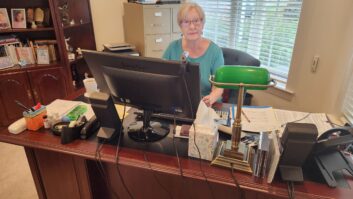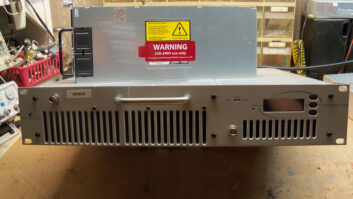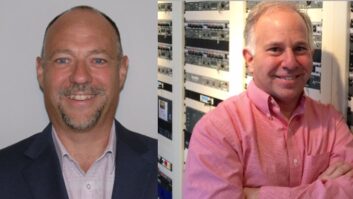Engineering consultants often are called upon to offer their expertise in matters concerning signal coverage improvement, AM directional antenna optimization such as necessitated by IBOC, interference/RFR issue resolution and maximizing vertical real estate potential.
Many times, broadcasters have a facility that fails to cover their desired audience. This usually is due to expansion in previously undeveloped areas. What once were farmlands and landfills have developed into shopping centers and condominium complexes.
Markets as defined by ratings firms dictate the necessity for providing adequate signal outside the original coverage design criteria.
Many AM transmitter sites were chosen 60 or more years ago when the audience was centered in different geographic areas than at present.
Older antenna designs are inefficient compared to today’s computer-designed optimized arrays.
(click thumbnail)iStockphoto/Chris Fertnig
Computers and other electronic equipment may diminish reception due to interference. Receivers inside metallic buildings may necessitate a stronger received signal. Increases in the value of antenna site real estate may dictate relocation or sharing a site with other broadcasters.
Techniques such as multiplexing, where two or more stations share the same antenna system, boosters, translators, site moves and optimized antennas are tools that can be used to improve coverage.
Engineering consultants can assist in these scenarios.
… So little time
I asked consultants about the typical questions and concerns they receive from clients.
“This morning’s first phone call was from a potential purchaser of a house near a local antenna farm. Last week included a call about lightning protection. An inquiry from an existing client related to a 20-year-old mistake by the FCC in a license grant.
“This morning’s first task was an STA application to extend FCC Rules §73.1615 authority for a client’s station that is implementing a new DA pattern. This morning’s next task will be regarding an impedance match network, and following that, a task to design isolation for a UHF antenna on an AM antenna system.”
The range of questions on which a consultant can assist is wide.
A potential homeowner may have questions regarding radio frequency radiation and/or interference to consumer electronic devices given their proximity to an antenna farm.
A client may be concerned regarding a facility’s susceptibility to lightning damage and what measures can be taken to minimize it.
How can a station address an error with the FCC in a license grant that occurred long ago? How can a client get an extension of Special Temporary Authority to operate at variance while an AM directional array is under modification.
What is the proper isolation on a tower to allow an AM station to realize revenue from leasing space to a UHF television broadcaster’s antenna? What is the impedance matching network design that will permit optimized bandwidth for the AM station? How can the station design an effective studio-transmitter link, file for it and do the frequency coordination?
Other inquiries concern both AM and FM IBOC installations. What equipment do I need? Which method is best for FM IBOC? Does our antenna system meet the minimum requirements? If not, what steps are needed to make it so? What are the predicted costs?
With increased real estate values for land that was once on the outskirts of town, many AM directional stations find themselves with the opportunity to cash in on the sale of the antenna property. Local zoning rules may make it difficult, or impossible, to relocate towers.
One solution is to diplex, or transmit two or more signals from a single tower (for non-directional) or multiple towers for directional modes. This minimizes the need for real estate while maximizing profit from a land sale. Many such multiplexed systems are in operation.
More popular is the multi-station FM antenna system. In major cities such as New York, Chicago and others, master FM antennas are common due to the limited number of tall buildings or towers.
For IBOC operation, bandwidth is a concern for both AM and FM stations. For directional AM, both impedance and pattern bandwidth are important.
Ask around
How do you choose a consultant? First define your needs as specifically as possible.
If you know another broadcaster who faced a situation similar to yours, contact them and ask which consultant they employed and what their experiences, positive or negative, were.
If such information presents a conflict, the consultant may have filed the FCC application. If so, his/her name would be on the application. This information can be obtained from FCC public records.
Approach several consultants. Ask them how they would treat your needs. Ask for references and their experiences in similar situations.
Clarence Beverage, a partner in Communications Technologies Inc., said he hears these questions from clients: “What are your and your firm’s particular areas of expertise? Have you done work for any other clients in my geographic area? If so, would you mind if I spoke with one or two? Why do I need FCC legal counsel in addition to your services; can you give me references in this regard?”
I asked one consultant how new clients are treated when they approach the firm.
“When we talk with a potential client we simply tell them what we think we can do for them. It’s often useful to describe our work on a previous similar project. If we can’t do anything useful or interesting, we tell them so. If we have a conflict of interest we have a (very!) short list of other firms we send them to, usually to a specific engineer who we know is knowledgeable and experienced on the subject at hand.”
Relevant information may include the consultant’s experience in filing FCC applications, interacting with the commission’s engineering staff and equipment manufacturers as well as knowledge of related fields such as aviation, architecture, structural issues, zoning and so forth.
One resource is the Association of Federal Communications Consulting Engineers (AFCCE). Many consultants are members of this organization. Its list is at www.afcce.org/Members.htm.
Another is the Society of Broadcast Engineers. Its Web site is www.sbe.org. A list of SBE members who offer contract and/or consulting work is at www.sbe.org/res_eng.php.
Recommendations from fellow broadcasters, your communications counsel, equipment manufacturers and suppliers should yield ideas to explore.
One important ingredient is rapport with the person to whom you entrust your facility. Also, just as with medical decisions, get a second and even third opinion.
In some cases, you may have more than one option. Some consultants may have tools such as software or experience with FCC policies (as opposed to rules) that can aid in your situation.
In one specific case we heard about, it was possible to nearly quadruple an FM station’s audience by decreasing power (Class B to B1 change) and relocating the tower inland near the population center. A consultant may be able to assist your facility with upgrades or improvements that increase audience, revenue and worth.













